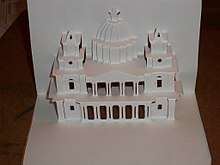Kirigami
Kirigami (切り紙) is a variation of origami that includes cutting of the paper, rather than solely folding the paper as is the case with origami, but typically does not use glue.

Overview
In the United States, the term "Kirigami" was coined by Florence Temko from Japanese kiri "cut," kami "paper", in the title of her 1962 book, Kirigami, the Creative Art of Papercutting. The book was so successful that the word kirigami was accepted as the western name for the art of paper cutting.[1]
Typically, kirigami starts with a folded base, which is then unfolded; cuts are then opened and flattened to make the finished kirigami. Simple Kirigami are usually symmetrical, such as snowflakes, pentagrams, or orchid blossoms. A difference between Kirigami and the art of "full base", or 180 degree opening structures, is that Kirigami is made out of a single piece of paper that has then been cut.
Notable Kirigami artists
- Seiji Fujishiro (藤城清治) (born 1924–), renowned Kirie Artist known for his colourful Paper Cuts which have also been published as a book.
- Giovanni Russo () (born 1969–), Italian Kirigami Designer known for his full detail Postcards which have also been sold in main bookshops worldwide.
- Nahoko Kojima (小島奈保子)(born 1981–), professional contemporary Japanese Paper Cut Artist. Pioneered sculptural Paper Cuts hanging in 3d.
See also
- History of origami
- Origamic architecture
- Paper cutting
- Paper model
External links
| Wikimedia Commons has media related to Kirigami. |
- The site of Kirigami in Russian and in English
- Kirigami model of Durban stadium
- Kirigami of Italian monuments
- gallery from Italy